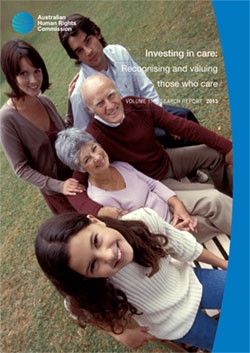Investing in care: Recognising and valuing those who care

Background
In 2009, the Commission examined the gender gap in retirement savings in the report, Accumulating poverty? Women’s experiences of inequality over the lifecycle. The report identified three strategies to redress women’s disadvantage in the current retirement income system including recognising and rewarding unpaid caring work in the retirement income system.
The research aims to expand on the findings made in the Accumulating poverty? report by:
- examining the nature of unpaid caring work in Australia and the barriers it creates for women’s equal participation in the workforce;
- identifying and analysing the different models and measures of valuing unpaid work and assessing the possible impact of such measures on the gender gap in retirement savings; and
- identifying and assesses the contemporary mechanisms in the workplace that support caring work.
Research Partners
The Australian Human Rights Commission engaged the Social Policy Research Centre (SPRC) at the University of NSW to undertake the research. The SPRC conducts research on all aspects of social policy and contributes to policy development and evaluation.
For more information about the research project download the project Fact Sheet.
Why recognise and value unpaid carers?
There are nearly 5.5 million unpaid carers between the ages of 15 to 64 years in Australia.1 They can be divided into two main groups - parents (who include biological, step, adoptive, or foster parents, and grandparents or guardians with caring responsibilities for a dependent child); and carers (who include people caring for a family member or friend with disability, chronic illness or frailty due to older age).
In Australia, it is more common for women to provide care in all age groups between the ages of 18-74. Women are also more likely than men to have care responsibilities involving greater time and intensity. In the 15-64 years age group 72.5 per cent of primary carers were women.2 As women undertake the largest share of unpaid caring work, the undervaluing of unpaid caring work has had the greatest impact in economic terms on women’s retirement income and savings.
Average (mean) superannuation payouts for women just over half (57%) those of men. While this gender gap is also the result of gender inequalities over a lifetime, a significant contributor to the gap is reduced workforce participation due to unpaid caring work. Women who are unpaid carers have considerably lower rates of employment and are more likely to work in part-time and casual jobs. Less than 23 per cent of female primary carers were in full-time employment at any point across the age groups.
Unpaid care work is essential to families and communities and a valuable part of Australia’s social and economic fabric. Meaningful recognition of the importance of unpaid care work to society as a whole, is vital to the well-being and quality of life those who receive care and those who provide it. Investing in care will also help to generate significant social and economic benefits, including ensuring quality care is accessible, generating greater efficiency and productivity in businesses, improving gender equality and increasing the workforce participation and financial security of unpaid carers.
Reform options for investing in care
The research examined models and mechanisms used to valued unpaid care in 24 countries. Based on the research the report identified a number of potential reform options for recognising and valuing unpaid caring work.
The report proposes a combination of mechanisms for adoption in Australia, including:
- Strengthening legislation to recognise discrimination based on family responsibilities including caring. Introducing mechanisms like carer assessments to determine a carer’s support needs and carer cards for accessing services and entitlements which would allow unpaid carers to participate in society on a more equal footing.
- Ensuring that unpaid carers have the right to request flexible work arrangements and that employers are obligated to reasonably accommodate their requests.
- Ensuring that income support reflects the variable costs of providing care and does not penalise unpaid carers for engaging in education and training or participating in the workforce.
- Expanding and strengthening leave provisions for all unpaid carers to ensure that they can maintain their attachment to the workforce while also undertaking their care responsibilities.
- Properly resourcing and coordinating services for unpaid carers across jurisdictions and care sectors to ensure that unpaid carers and those they care for receive the benefits of these services.
- Introducing workplace initiatives and changes to workplace culture to support unpaid carers undertake their work and care responsibilities.
- Reforming the current system of retirement income and savings, including the age pension and superannuation that is tied to paid work, to account for the inequity of retirement incomes and savings that leaves many women in poverty in older age, especially women who are or have been unpaid carers.
Download
The Investing in care: Recognising and valuing those who care report comes in two volumes:
Volume 1 outlines the main findings of the research;
Volume 2 contains technical papers on specific aspects of unpaid care.
There is also a Community Guide which summarises the issues and options for reform.
The Commission has also produced Supporting carers in the workplace: A toolkit. The Toolkit provides practical examples of mechanisms that workplaces can use to support unpaid carers and help them to meet their caring responsibilities.
- Volume 1: Research report
- Volume 1: Research report
- Volume 2: Technical papers
- Volume 2: Technical papers
- Community Guide
- Community Guide
- Toolkit
- Toolkit
- Fact sheet about the project
- Fact sheet about the project
1 Australian Bureau of Statistics, Survey of Disability, Ageing and Carers, Australia 2009, Basic CURF, Version 3, CD-Rom (2009). Findings based on SPRC’s analysis of ABS CURF data.
2 Australian Bureau of Statistics, Caring in the Community, Australia, Catalogue no. 4436.0 (2012), p 21, Table 8. At http://www.abs.gov.au/AUSSTATS/abs@.nsf/DetailsPage/4436.02009?OpenDocument (viewed 14 September 2012).
